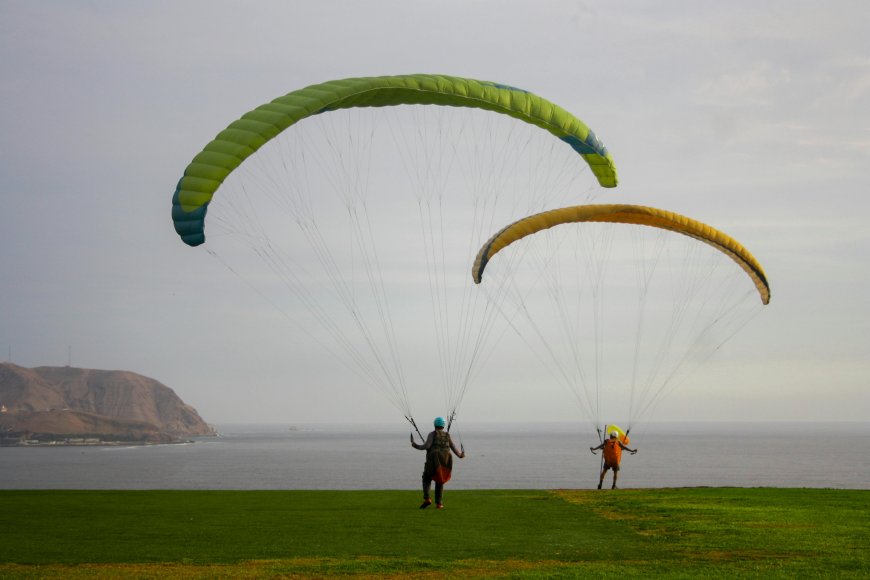Basic Skydiving Instructions
Skydiving: Succeeding in this thrilling sport involves following several basic guidelines. First and foremost, proper training is essential to ensure your safety and an enjoyable experience. Regularly check your equipment, including the parachute, reserve parachute, and safety harness, to ensure they are ready for use. Be meticulous in assessing weather conditions and avoid jumping in unfavorable weather. Carefully designate a landing area and avoid crowded areas, as well as the risk of colliding with objects. By adhering to these guidelines, you'll be able to enjoy the skydiving experience safely and confidently.

Skydiving: Succeeding in this thrilling sport involves following several basic guidelines. First and foremost, proper training is essential to ensure your safety and an enjoyable experience. Regularly check your equipment, including the parachute, reserve parachute, and safety harness, to ensure they are ready for use. Be meticulous in assessing weather conditions and avoid jumping in unfavorable weather. Carefully designate a landing area and avoid crowded areas, as well as the risk of colliding with objects. By adhering to these guidelines, you'll be able to enjoy the skydiving experience safely and confidently.
Basic Skydiving Instructions
Skydiving is an exhilarating and enjoyable activity that requires a set of fundamentals to ensure safety and full enjoyment of the experience. For beginners, it's essential to start by getting proper training from professional instructors at certified skydiving centers. Basic training includes learning how to control the parachute during descent and flight, as well as dealing with emergency situations.
One of the key aspects of skydiving is checking the skydiving gear before each adventure. Ensuring the safety and readiness of the parachute, safety harness, and all other associated equipment is crucial. It's also important to check the weather conditions before jumping to ensure there are no strong winds or unsuitable weather conditions for skydiving.
When jumping, the trainee must be centered and focused, and follow the instructors' instructions accurately. After jumping, the skydiver should be able to control the direction of flight and land smoothly and safely. It's also important to designate a suitable landing area and avoid hazardous areas such as trees and power lines.
By respecting these fundamentals and following necessary guidelines, anyone can enjoy the skydiving experience safely and confidently, allowing them the opportunity to discover the unique joy of flying and freedom in the air.
Basic Steps for Preparation and Execution
Preparing for and executing a skydiving jump requires adhering to specific steps to ensure safety and a successful experience. Here are details about the basic steps:
1. Acquiring Knowledge and Training: Before starting anything, individuals must acquire sufficient knowledge about skydiving. They should join certified training courses and train under the supervision of professional instructors.
2. Equipment Check: It's essential to ensure the safety and readiness of equipment before each jump. Regularly inspect the parachute, reserve parachute, safety harness, and other associated equipment.
3. Assessing Weather Conditions: Skydivers should check the weather conditions before jumping. Avoid jumping in unfavorable weather conditions such as strong winds or storms.
4. Designating Landing Point: Skydivers must designate a suitable landing area before takeoff. Avoid random areas and choose a good landing point to ensure safety.
5. Checking Airspace: Before jumping, skydivers should check for any other aircraft or vehicles in the designated airspace for jumping.
6. Guidance and Safe Landing: During the jump, the skydiver must guide their parachute carefully and follow safe landing instructions. Avoid colliding with objects and individuals upon landing.
7. Reviewing Performance and Improvement: After each jump, the skydiver should review their performance and identify areas for improvement for future jumps.
By following these basic steps, skydivers can enjoy the experience safely and confidently.
Ensuring Safety During Skydiving
Ensuring safety during skydiving is of utmost importance for every skydiver. Here are detailed procedures that can be taken to ensure safety during the jump
1. Regular Equipment Inspection: Before each jump, the skydiver must thoroughly inspect all equipment used. This includes checking the parachute itself, the reserve parachute, the safety harness, and all other accessories. Any damages or defects should be identified and repaired or replaced if necessary.
2. Careful Weather Evaluation: Skydivers should carefully monitor the weather conditions before jumping. Avoid jumping in unfavorable weather conditions such as strong winds, heavy rain, or thunderstorms. Wait until conditions are suitable before taking off.
3. Ensuring Safety in Landing Zones: Skydivers must designate a safe landing area free of obstacles before taking off. Avoid jumping in crowded areas or near buildings or trees. Also, ensure there are no obstacles in the potential landing path.
4. Communication with Training Center or Skydiving Club: Skydivers should communicate with the training center or skydiving club to obtain necessary information about weather conditions, equipment, and any safety-related updates.
5. Pre-Jump Parachute and Gear Check: Before jumping, the skydiver must ensure that everything is in good condition and ready for use. This includes checking the parachute for safety and any defects or damages, and ensuring the stability and quality of all associated gear.
6. Reviewing Emergency Procedures: Skydivers should be familiar with emergency procedures and the necessary measures to take in emergency situations such as parachute failure or other landing problems.
By following these guidelines, skydivers can enjoy the skydiving experience with the highest levels of safety and confidence.
Skydiving Equipment
Parachuting equipment comprises a set of essential gear that a skydiver needs to ensure their safety and the success of the jump. Here are detailed descriptions of this equipment and its importance in skydiving safety
1. Main Parachute: The main parachute is the most critical piece of skydiving equipment. A good parachute is characterized by its strong structure and high-quality materials, ensuring safety and stability during descent. Regular inspection of the parachute is necessary to ensure its safety and absence of any damages.
2. Reserve Parachute: The reserve parachute is a vital piece of equipment for emergency situations, used in case of main parachute failure. The reserve parachute must be ready for use and undergo regular inspections to ensure its safety.
3. Harness: The harness connects the skydiver to the parachute and assists them in controlling their movement during the jump and landing. The harness should be sturdy and reliable, and regular inspection is necessary to ensure there are no damages or defects.
4. Communication and Navigation Equipment: This includes electronic devices such as communication devices and navigation tools that help the skydiver communicate with ground support teams and determine their location in the air.
5. Protective Equipment and Special Clothing: These include protective helmets, sunglasses, and skydiving suits that provide protection against external factors such as the sun, wind, and cold.
6. Water Rescue Equipment: In case of a water landing, water rescue equipment such as life jackets and emergency water devices must be provided.
Providing all of this equipment and ensuring its readiness and safety contributes to increasing the level of safety and confidence during skydiving.
How to Choose Suitable Conditions for Skydiving
Choosing suitable conditions for skydiving is a crucial factor that greatly impacts the safety and success of the jump. Here are detailed steps on how to choose suitable conditions
1. Assessing Weather Conditions: Skydivers must carefully assess the weather conditions before jumping. They should check local weather reports and monitor sudden changes in weather conditions. It's worth noting that strong winds, thunderstorms, and dense fog can make jumping unsafe.
2. Evaluating Potential Jump Sites: Skydivers should pre-evaluate potential jump sites and determine if those areas have safe conditions for jumping. They should avoid jumping in areas with obstacles such as buildings, trees, or power lines.
3. Analyzing Airspace: Before jumping, skydivers should analyze the surrounding airspace to ensure there are no other aircraft or helicopters in the area. They should also be mindful of congested airspace areas that need to be avoided.
4. Determining Suitable Jump Time: The jump time should also be appropriate for the weather conditions. It's preferable to jump when the wind speed is low and the sky is clear. Jumping in unstable weather conditions or during darkness should be avoided unless the skydiver is well qualified for night jumps.
5. Consulting Specialists and Experts: In case of doubt or uncertainty about the suitability of conditions for jumping, skydivers should consult specialists and experts in the field to obtain the best advice and guidance.
By following these steps and adhering to safety guidelines, skydivers can choose suitable conditions for skydiving with confidence and safety.
Safe Landing Zones
Identifying safe landing zones is an essential part of planning and executing skydiving jumps, as it significantly impacts the skydiver's safety and the success of the jump. Here are detailed guidelines on how to choose safe landing zones:
1. Terrain and Obstacles: Avoid selecting landing areas that contain obstacles such as buildings, trees, fences, or power lines. Look for open areas free from obstacles that could endanger the skydiver's life.
2. Weather Variations: Avoid choosing landing areas affected by weather variations such as strong air currents or thunderstorms. It's better to select areas that are meteorologically stable and free from significant wind fluctuations.
3. Intersections and Public Facilities: Avoid landing in areas where roads or highways intersect, as well as areas crowded with public facilities such as schools or hospitals.
4. Safety Distance: Choose landing zones that provide sufficient safety distance for the skydiver to land and come to a safe stop without colliding with obstacles or people.
5. Ground Communication: Skydivers should communicate with the ground team and designate the appropriate landing location, ensuring clear markings to facilitate a safe landing.
6. Pre-Evaluation: Skydivers should conduct a pre-evaluation of the selected landing area, including examining the terrain and identifying suitable maneuvering and landing sites.
By choosing safe landing zones and ensuring their readiness and safety, skydivers can enjoy the experience of parachute landing with the utmost level of safety and confidence.
Enjoy freedom and excitement with complete confidence
Enjoying the freedom and excitement with complete confidence is the essence of skydiving, where skydivers can indulge in feelings of freedom and excitement safely and confidently. Here are detailed steps on how to achieve that:
1. **Good Training and Preparation:** It all starts with intensive training and good preparation before the jump. Through regular training and thorough preparation, skydivers can acquire the necessary skills and build confidence in their ability to control the parachute and execute safe landings.
2. **Managing Fear and Anxiety:** It's natural for skydivers to feel fear and anxiety before jumping, but they learn how to manage these feelings and channel them into positive energy that helps them succeed in the jump.
3. **Confidence in Equipment and Gear:** Checking the equipment and ensuring its readiness and safety helps build confidence in the tools that skydivers rely on during the jump.
4. **Adhering to Safety Guidelines and Instructions:** Following safety guidelines and adhering to the instructions of instructors helps increase confidence in the steps and movements they take during the jump.
5. **Enjoying the Experience Mindfully:** Fully immersing oneself in the experience and enjoying every moment of it helps build confidence and enhance positive feelings during the jump.
6. **Exercising Patience and Gradual Progression:** Exercising patience and focusing on gradual progression helps achieve success and build confidence continuously, allowing skydivers to set and achieve their goals with confidence and determination.
By following these steps, skydivers can enjoy the experience of skydiving with complete freedom, excitement, and full confidence in their ability to control and handle situations safely and confidently.
Summary
Basic guidelines for skydiving include several important aspects aimed at ensuring the safety and success of the experience. This includes thorough preparation and regular equipment checks, as well as choosing suitable conditions for skydiving in terms of weather and location. Additionally, the skydiver should identify safe landing areas and have sufficient confidence in their skills while adhering to safety instructions. By following these guidelines, skydivers can enjoy the experience with maximum safety and confidence.
Sources
1. International Parachuting Commission (IPC)
- Provides reliable information and guidance on the international laws and regulations governing parachuting.
2. Dropzone.com
- An online forum and community for skydiving enthusiasts containing tips, personal experiences, and guidance.
3. Parachutist Magazine
- Offers articles and educational resources on skydiving techniques and safety guidelines.
What's Your Reaction?



































































































































































